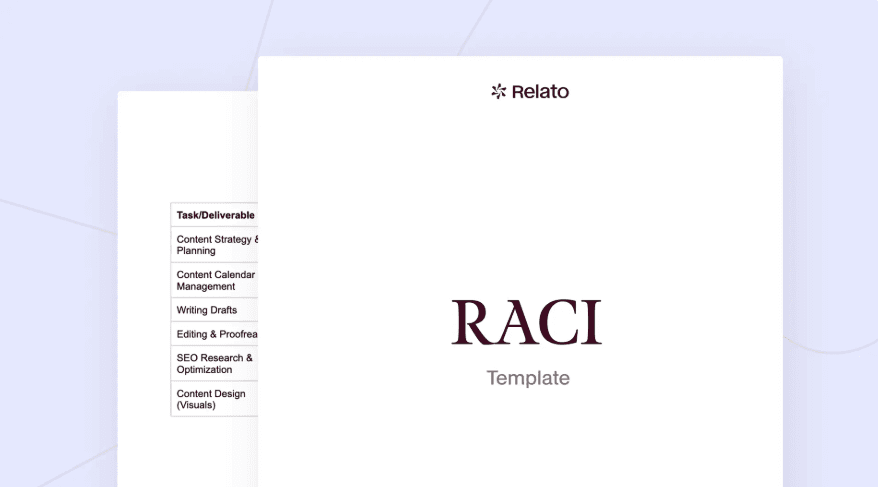Too Many Cooks in the Kitchen? How to Define Content Ownership and Protect Your Strategy
Ever feel like your content process is one comment away from chaos? If you're constantly battling late-stage feedback and unclear ownership, it’s time to draw the line and take control before your strategy gets steamrolled.

You’re polishing the final draft of your latest campaign. The hard part’s done, right? Then a last-minute comment pops up. A stakeholder, who hasn’t been involved until now, questions the entire direction of the piece. And just like that, you’re dragged back to square one.
Katie Norris, former Content Lead at Adyen, calls this the “death by too many cooks.” It’s when every voice has input, but no one takes ownership. Feedback spirals, revisions multiply, and deadlines slip. Your content strategy? Gone. Without clear roles or structure, your team gets trapped in endless rework.
But this can be avoided. Defining roles early and managing feedback keeps everything on track. Stakeholders know when to contribute, and workflows stay tight. Your team can finally focus on creating high-impact content.
Why boundaries and ownership are non-negotiable
When teams operate without structure, the result is chaos. Competing priorities, endless feedback, and rework derail even the best strategies. Setting clear boundaries and defining ownership from the outset isn’t just helpful — it’s essential to producing goal-driven, high-quality content.
Here’s how it works:
Clarity saves strategy
Every piece of content needs a clear owner — someone responsible for shaping the tone, direction, and overall strategy. Without this, decisions get diluted by competing voices, and projects veer off course.
Defined content team roles prevent unnecessary voices from drowning out the vision. Everyone knows their purpose — whether shaping creative direction, advising on compliance, or offering product input. Without clarity, confusion and competing feedback take over.
But this lack of ownership is surprisingly common. The Content Marketing Institute found that 24% of B2B companies don’t have dedicated content teams. Instead, various departments or "whoever’s available" take on content tasks, causing shifting priorities and reactive execution. Without a leader to guide strategy, progress stalls.
“When everyone in a team is responsible for content, no one is truly accountable.”
As Livia Hirsch, Freelance Content Writer and Strategist, points out, when everyone in a team is responsible for content, no one is truly accountable. One person must take the lead to gather feedback, track deliverables, and maintain alignment across teams. Ownership drives consistency, keeps processes moving forward, and ensures that each piece of content fits into the larger strategic puzzle.
“A content strategy without ownership is like a puzzle no one’s putting together — nothing moves forward. You need one person to own the process, or the whole thing falls apart.”
Focus enables results
Distractions slow down production and dilute the impact of your content. Without a structured workflow, teams waste time navigating conflicting feedback, chasing approvals, and revisiting the same project over and over. Energy that should be spent on research, creativity, and execution gets drained by unnecessary back-and-forth.
Too many cooks means too many distractions. Stakeholders chime in with off-topic feedback, dragging out review cycles. With a streamlined workflow, teams focus on producing high-impact content instead of firefighting.
Trust reduces bottlenecks
Unclear roles breed uncertainty. Stakeholders jump in randomly, delaying decisions. But when responsibilities are clear, teams trust the process. Approvals move quickly, and projects stay on schedule.
Ownership isn’t about excluding people. It’s about involving them at the right time. When clarity, focus, and trust drive your operations, your strategy transforms into a well-oiled system that delivers results.
How to systematize content ownership
Every content marketer has learned what happens when no one owns the process. One too many last-minute comments forced her to rethink how stakeholder involvement was managed. The solution? A structured process that smoothes out collaboration.
Here’s how:
The right interface
At Adyen, Norris’ team worked with a marketing stakeholder who acted as a bridge between content and other departments. This person filtered feedback and channeled it productively, reducing noise and keeping the team focused.
Ashley Faus, Head of Lifecycle Marketing at Atlassian, explains this well: delegation keeps control with the manager, while passing the baton gives ownership to the person doing the work. When people have full control over their tasks, they move projects forward, make decisions, and adjust as needed, without waiting for approval at every step.
“Delegation keeps control with the manager, while passing the baton gives ownership to the person doing the work.”
Giving key stakeholders ownership of specific responsibilities ensures they have full control and context to contribute effectively. This prevents bottlenecks where a single manager or lead is overwhelmed by decision-making for every request.
Timing is everything
Make sure stakeholders were looped in at key moments, not whenever they felt like chiming in. Product input needs to come early, legal reviews should be done at predefined points, and leadership alignment needs to happen before final drafts. This sequencing means every voice contributes where it matters most, preventing the endless revision cycles that derail progress.
RACI in action

To make roles crystal clear, you may want to try out a RACI framework. The framework identifies:
- Responsible: Who does the work (usually the content creator)
- Accountable: Who makes the decisions
- Consulted: Who provides expert input
- Informed: Who needs updates
This system leaves no room for ambiguity. Everyone understands their role from the outset, which eliminates guesswork and frustration. Decisions become faster, collaboration stays productive, and the strategy holds firm through each phase of content creation.
Actionable strategies to take control
Content projects feel like tug-of-war when roles aren’t clear. But a few strategic tweaks can fix that. Here’s how to regain control:
Set roles early
Ownership starts before work begins. Define who’s responsible, accountable, consulted, and informed. This prevents conflicting feedback and keeps everyone aligned.
A lack of ownership is a common reason B2B content strategies fail. Teams face competing priorities because no one drives strategy forward. Early role-setting protects your workflow from derailment.
Adopt a gatekeeper mindset
Appoint a stakeholder to manage external input. This person filters distractions without blocking important feedback. Their role is to keep your team focused on the right voices.
Streamline feedback
Establish clear feedback stages. Product reviews come early. Legal checks occur during drafts. Final sign-off happens at the end. This prevents last-minute “Why are we doing this?” comments that wreck progress.
“It’s tempting to treat 'writing content' as one step. But creating great content takes many. Do it all yourself, and you’ll burn out before you scale.”
As Leigh McKenzie highlights, a structured feedback process is key to scaling content without sacrificing quality. When check-ins are intentional and each stage has a clear owner, teams avoid unnecessary revisions and keep workflows efficient.
Centralize communication
Chasing feedback across email threads, Slack messages, and random Google Docs slows everything down. Centralizing communication in a single system makes collaboration smoother.
Use tools like Relato to organize feedback, manage approvals, and create a shared source of truth for every project. When your team has one place to track progress, you avoid wasting time hunting for scattered updates.
The payoff: a strategy that delivers
When everyone knows their role, your content team moves from survival mode to thriving. No more firefighting or late-night revisions from surprise stakeholders.
Projects get delivered on time and with purpose. Stakeholders trust the process because they’re involved when it matters. Approvals are faster, feedback is focused, and delays disappear.
Ownership and structure unlock momentum. Your team can focus on what they do best — creating impactful content that drives results.
Ready to take control of your content process? See how Relato’s workflows can streamline collaboration, simplify approvals, and keep your strategy on track. Schedule a demo today.